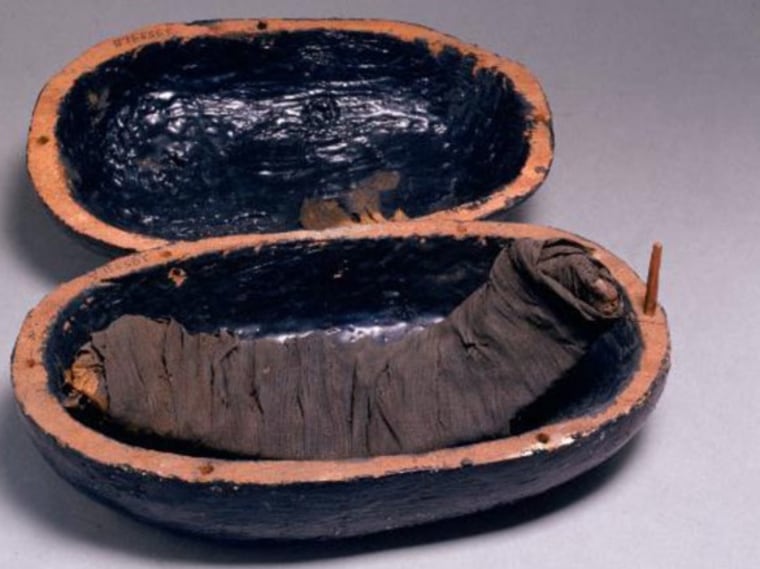The ancient Egyptians believed that humans carried material possessions into a party in the afterlife, and meticulously stocked tombs with clothing, jewelry, furniture, and most important, food.
Chambers were laid out like a freezer with no expiration date, crammed with grains, bread, wine, beer, oil and hunks of meat — the food of the wealthy — dried, flavored and bandaged in linen.
New analysis of such "meat mummy" samples from tombs built in the 14th century B.C. indicates that those packed picnics weren’t a slapdash affair. The attention and cost poured into the preparation of food mummies matched or rivaled the care lavished on the pickled humans — if they were rich enough to afford the deluxe packaging.
"The resin flavor would have made it nicer, sort of like Teriyaki beef jerky rather than plain beef jerky," Salima Ikram, an Egyptologist at the American University in Cairo who specializes in meat mummies, and has experimentally mummified rabbits and fish in her lab, told NBC News.
Ikram and her colleagues examined samples of goat, calf, duck and beef ribs from the Cairo Museum and British Museum. In the beef rib samples, from the private stash of the royal family, they found traces of Pistacia resin in the bandages that may have helped preserve and flavor the meat.
Resins are commonly found in human mummies, but this particular resin was a luxury item, imported into Egypt from places like Syria and Lebanon, the team explains in a new study published in the Monday issue of the Proceedings of the National Academy of Sciences.
After millennia, food mummy samples still tend to look appetizing. "The poultry looks like you’ve just gone to Safeway and bought a roast bird," Ikram said, all except for the wrappings, "And they’re almost 4,000 years old."
These particular samples were chosen because they were representative of the food mummies, and had bits of meat falling off, and could be analyzed without damaging a historical sample.
Meat mummies were included in the afterlife checklist around 1550 B.C. and the practice has been thought to continue until 1200 B.C. "Tutankhamen had about 40 boxes of meat and poultry — remember, he was a growing boy so his appetite was considerable," Ikram said.
Among her more remarkable finds: a carefully wrapped tail of an ox, and a delicate dish of lungs and windpipes from the tomb of Queen Isetemkheb.
"It’s kind of cool to think of oxtail soup as being on the menu for the afterlife," she said. The lung-and-windpipe combination platter may have been symbolic of "a unified Egypt under a single king," in addition to being just plain old tasty.
Animal mummies were also companions and symbols of good luck. Whole menageries have been found preserved, including cattle, dogs, cats, fish, scarab beetles, mice — and in Ikram’s favorite example, an 18-foot long mummified crocodile, a sacred animal in ancient Egypt, found with crocodile babies in its jaws.
The authors of "Organic chemistry of balms used in the preparation of pharaonic meat mummies," published in PNAS, are Katherine Clark, Salima Ikram and Richard Evershed.
Nidhi Subbaraman writes about science and technology. You can follow her on Facebook, Twitter and Google+.
